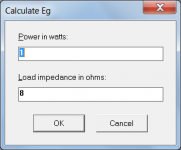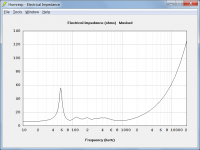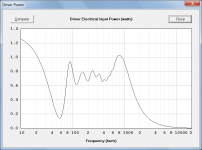Simulation is at one metre with you in control of the power input in the Eg field top second from the left.
Many manufacturers used 1W @1m SPL. What is the power response equivalent to SPL in HR?
Hi 1hiep0,
Further to Mark's post, the only way to sensibly interpret 1W @ 1m SPL is to also know what nominal input impedance is being assumed. If the assumed load impedance is 8 ohms, then the required input voltage (Eg) to deliver 1 watt is 2.83 volts. If the load impedance is 4 ohms, then the required input voltage for 1 watt is 2.00 volts.
Double-click on the Eg input box in Edit mode to calculate the voltage required to deliver a given power into a given nominal load impedance.
The actual power delivered will vary considerably from the nominal power value because the input voltage is constant, and the input impedance changes with frequency.
The Hornresp power response results are referenced to 1 metre.
Kind regards,
David
Attachments
Maybe the term "actual power drawn from the source (amplifier)" would be a better choice. "Power delivered" might be taken to mean the acoustic power delivered by the loudspeaker/horn system.
Good point, thanks SamAnytime.
Just to clarify, all references to power and wattage in my previous post apply to electrical input power (as shown in Attachment 3), not to acoustical output power.
Just to clarify, all references to power and wattage in my previous post apply to electrical input power (as shown in Attachment 3), not to acoustical output power.
Manufactures making a mess about that sensitivity number.
Usually it should be the sensitivity dB/W calculated with the Re, not nominal resistance.
It's good to point out the ACTUAL power delivered by the amplifier, which can be a lot lower than a lot of people might think.
In some cases amplifiers will reach their maximum voltage before their maximum power.
Something that has been shown extremely misleading in WinISD (as an example) for many many years.
Usually it should be the sensitivity dB/W calculated with the Re, not nominal resistance.
It's good to point out the ACTUAL power delivered by the amplifier, which can be a lot lower than a lot of people might think.
In some cases amplifiers will reach their maximum voltage before their maximum power.
Something that has been shown extremely misleading in WinISD (as an example) for many many years.
This discussion has come up again.
Sensitivity is not measured in terms of dB/W, but in terms of dB/V, e.g. "86dB/2.83V/1M". The speaker's impedance is irrelevant to such a measurement.
The speaker's impedance only becomes relevant when you want to consider the how many watts are consumed (drawn from the amp) at a particular signal voltage level and signal frequency when applied to a speaker. But now we're talking about ***efficiency***, not ***sensitivity*** 🙂.
In fact, if we'd started measuring sensitivity in terms of dB/1V/1M, there'd probably be a whole lot less confusion over the terms, LOL, because that silly "2.83" thing is IMO a "ratch" to represent the voltage needed for exactly one watt to be dissipated by an 8 ohm resistance, and there are very, very, few dynamic drivers that present anything like a pure resistive load to the amplifier.
Even then, quoting that information like "86dB/1W/1M" for efficiency is misleading because a speaker's power consumption at a particular voltage level is VERY frequency-dependent. TBH I don't think that figure has any real usefulness. I've never really used it in any of my design work.
Sensitivity is not measured in terms of dB/W, but in terms of dB/V, e.g. "86dB/2.83V/1M". The speaker's impedance is irrelevant to such a measurement.
The speaker's impedance only becomes relevant when you want to consider the how many watts are consumed (drawn from the amp) at a particular signal voltage level and signal frequency when applied to a speaker. But now we're talking about ***efficiency***, not ***sensitivity*** 🙂.
In fact, if we'd started measuring sensitivity in terms of dB/1V/1M, there'd probably be a whole lot less confusion over the terms, LOL, because that silly "2.83" thing is IMO a "ratch" to represent the voltage needed for exactly one watt to be dissipated by an 8 ohm resistance, and there are very, very, few dynamic drivers that present anything like a pure resistive load to the amplifier.
Even then, quoting that information like "86dB/1W/1M" for efficiency is misleading because a speaker's power consumption at a particular voltage level is VERY frequency-dependent. TBH I don't think that figure has any real usefulness. I've never really used it in any of my design work.
No idea were you got that idea from, put giving sensitivity per volt is even more misleading, since a 4ohm speaker will have a much different sensitivity than a 8ohm speaker in terms of power efficiency. Which you won't see when dB/V is being used.
See;
Thiele/Small parameters - Wikipedia
In the end the whole efficiency number is part of the T/S parameters.
So technically speaking, the freq resp doesn't have anything to do with it!
In general one should give both, and yes I do agree with the fact that it also doesn't tell the whole story at all.
But it's a decent number to get a good sense for full-range systems what speaker needs less power.
In the end (energy) efficiency is always calculated with power.
See;
Thiele/Small parameters - Wikipedia
In the end the whole efficiency number is part of the T/S parameters.
So technically speaking, the freq resp doesn't have anything to do with it!
In general one should give both, and yes I do agree with the fact that it also doesn't tell the whole story at all.
But it's a decent number to get a good sense for full-range systems what speaker needs less power.
In the end (energy) efficiency is always calculated with power.
Impedance has no effect on sensitivity. It effects efficiency. A 4 ohm speaker will consume more power than an 8 ohm speaker with the same rated sensitivity, but if you hook up a 4 ohm speaker and an 8 ohm speaker with the same sensitivity rating to an amplifier, they will provide exactly the same SPL output at any gain setting on the amp, up to the point that either the amplifier's limits are exceeded or the speaker's limits are exceeded.
The information at that Wikipedia link is misleading too. Sensitivity as far as speakers are concerned should be always measured in terms of dB/2.83V/1M, not 1W/1M. Efficiency is measured in terms of 1W/1M. While one term can be calculated from the other (by using the previously-mentioned "nominal impedance"), and therefore identical in magnitude at 8 ohms, the terms are different and describe different things. For example, the sensitivity rating can give an idea of how much voltage would be required to achieve a particular SPL from the speaker and the efficiency rating can give an idea of how much power will be consumed by a speaker at a given SPL.
The information at that Wikipedia link is misleading too. Sensitivity as far as speakers are concerned should be always measured in terms of dB/2.83V/1M, not 1W/1M. Efficiency is measured in terms of 1W/1M. While one term can be calculated from the other (by using the previously-mentioned "nominal impedance"), and therefore identical in magnitude at 8 ohms, the terms are different and describe different things. For example, the sensitivity rating can give an idea of how much voltage would be required to achieve a particular SPL from the speaker and the efficiency rating can give an idea of how much power will be consumed by a speaker at a given SPL.
Last edited:
confusing....yes
I am interesting the relationship between HR dB power response and dB SPL response as provided in manufactory specification. What is their difference is in the unit? Thanks
I am interesting the relationship between HR dB power response and dB SPL response as provided in manufactory specification. What is their difference is in the unit? Thanks
To add even more to the confusion, many (if not all) of these terms are not constants, but vary with frequency.
Impedance has no effect on sensitivity. It effects efficiency. A 4 ohm speaker will consume more power than an 8 ohm speaker with the same rated sensitivity, but if you hook up a 4 ohm speaker and an 8 ohm speaker with the same sensitivity rating to an amplifier, they will provide exactly the same SPL output at any gain setting on the amp, up to the point that either the amplifier's limits are exceeded or the speaker's limits are exceeded.
The information at that Wikipedia link is misleading too. Sensitivity as far as speakers are concerned should be always measured in terms of dB/2.83V/1M, not 1W/1M. Efficiency is measured in terms of 1W/1M. While one term can be calculated from the other (by using the previously-mentioned "nominal impedance"), and therefore identical in magnitude at 8 ohms, the terms are different and describe different things. For example, the sensitivity rating can give an idea of how much voltage would be required to achieve a particular SPL from the speaker and the efficiency rating can give an idea of how much power will be consumed by a speaker at a given SPL.
For loudspeakers, efficiency and sensitivity are directly related to each other.
Related, but not the same thing. They are described and defined using different units of measure.
Oh my. Play nice Gentlemen you are both correct on the opposite sides of the same coin.
You both know what you are doing I remember good work from both of you.
I dislike the way the industry has ran a numbers game as much as anyone else. 2.83 volts has been abused for a long time. As has the fictitious what frequency. It is supposed to be 1kilohertz for most drivers. Or pink noise depending on the reference standard. But as in almost all things audio the ability to really standardize things would show up the garbage from the gems rather rapidly. And we don't want that to happen says the sales department!
Tell me again how many watts is that speaker???
You both know what you are doing I remember good work from both of you.
I dislike the way the industry has ran a numbers game as much as anyone else. 2.83 volts has been abused for a long time. As has the fictitious what frequency. It is supposed to be 1kilohertz for most drivers. Or pink noise depending on the reference standard. But as in almost all things audio the ability to really standardize things would show up the garbage from the gems rather rapidly. And we don't want that to happen says the sales department!
Tell me again how many watts is that speaker???
Free air? Use the input wizard to generate a half space direct radiator flat open baffle and then plug in the driver parameters that you want.
Make the flat baffle whatever size you want. It will have to large enough to have the driver on it but that is enough.
Make the flat baffle whatever size you want. It will have to large enough to have the driver on it but that is enough.
Hi,
Could HR model in free air? Probably not I think! Thanks. 😀
Ang 4
(or Ang 0 for infinite horns)
For loudspeakers, efficiency and sensitivity are directly related to each other.
The page linked below may be of interest:
Sensitivity/Efficiency in Loudspeakers | BASSBOSS Powered Loudspeakers
- Home
- Loudspeakers
- Subwoofers
- Hornresp


